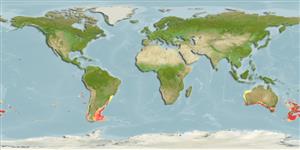Appear to live usually on or near the bottom, but may occasionally move up into mid-waters. Large adult fish generally occur deeper than 400 m, while juveniles may be found in shallower water (Ref. 9072), more commonly found in large estuaries and bays, and may even enter freshwaters (Ref. 1371). Juvenile specimens and especially adults belonging to the American subspecies, have been caught from the coastal zone to 110 m (Ref. 58452). Form schools. Feed primarily on lantern fishes. In New Zealand, it feeds in midwater on small fish, crustaceans and squid. Oviparous, spawn 1 million eggs on the average which are released all at one time (Ref. 6390). Utilized fresh and frozen; can be steamed, fried, cooked in microwave and baked (Ref. 9988).
似乎通常生活在底部上面或附近, 偶然地但是可能移动向上进入中层水域。 大的成鱼通常出现在较深处胜于 400 公尺, 而稚鱼可能被发现于较浅的水域 (参考文献 9072),多普遍发现于大的河口与海湾, 而且可能甚至进入淡水.(参考文献 1371) 形成鱼群。 主要捕食灯笼鱼。 在新西兰, 它在中层水域的吃捕食小鱼, 甲壳动物与乌贼。 生鲜使用与冷冻; 能在微波与烧烤被蒸,油炸, 煮。 (参考文献 9988) 新西兰这种的商业 Hoki 渔场已经被检定藉由海洋的总管职务会议 (http:// www.msc.org/) 当管理良好且族群能维持。
Preferred temperature (Ref.
115969): 5.8 - 12.5, mean 8 (based on 300 cells).
Phylogenetic diversity index (Ref.
82804): PD
50 = 0.5625 [Uniqueness, from 0.5 = low to 2.0 = high].
Bayesian length-weight: a=0.00389 (0.00219 - 0.00690), b=2.98 (2.82 - 3.14), in cm Total Length, based on LWR estimates for this species & (Sub)family-body (Ref.
93245).
营养阶层 (Ref.
69278): 4.5 ±0.2 se; based on diet studies.
回复力 (Ref.
120179): 低的, 最小族群倍增时间4.5 - 14 年 (K=0.12-0.2; tm=3-7; tmax=25; Fec = 1,000,000).
Prior r = 0.29, 95% CL = 0.19 - 0.44, Based on 3 full stock assessments.
Fishing Vulnerability (Ref.
59153): High to very high vulnerability (66 of 100).
Climate Vulnerability (Ref.
125649): High vulnerability (61 of 100).
